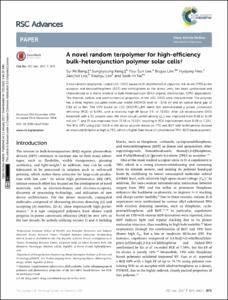Department of Energy Science and Engineering
Organic & Printed Electronics Laboratory(OPEL)
1. Journal Articles
Full metadata record
| DC Field | Value | Language |
|---|---|---|
| dc.contributor.author | Bang, Su-Mi | - |
| dc.contributor.author | Kang, Sungkyoung | - |
| dc.contributor.author | Lee, You-Sun | - |
| dc.contributor.author | Lim, Bogyu | - |
| dc.contributor.author | Heo, Hyojung | - |
| dc.contributor.author | Lee, Jaechol | - |
| dc.contributor.author | Lee, Youngu | - |
| dc.contributor.author | Na, Seok-In | - |
| dc.date.available | 2017-06-29T08:16:18Z | - |
| dc.date.created | 2017-04-10 | - |
| dc.date.issued | 2017 | - |
| dc.identifier.issn | 2046-2069 | - |
| dc.identifier.uri | http://hdl.handle.net/20.500.11750/2102 | - |
| dc.description.abstract | A new random terpolymer, coded LGC-D013, based on N-alkylthieno[3,4-c]pyrrole-4,6-dione (TPD) as the acceptor and benzodithiophene (BDT) and terthiophene as the donor units, has been synthesized and characterized as a donor material in bulk-heterojunction (BHJ) organic photovoltaic (OPV) applications. The thermal, optical, and electrochemical properties of the LGC-D013 were characterized. The polymer has a deep highest occupied molecular orbital (HOMO) level of −5.56 eV and an optical band gap of 1.84 eV in film. The OPV based on LGC-D013:PC71BM blend film demonstrated a power conversion efficiency (PCE) of 6.09%, with a relatively high fill factor (FF) of 72.55%. After 1,8-diiodooctane (DIO) treatment with a 3% volume ratio, the short circuit current density (Jsc) was improved from 9.48 to 11.29 mA cm−2, and FF was improved from 72.55 to 73.13%, resulting in PCE improvement from 6.09 to 7.22%. The BHJ OPV using LGC-D013 as the donor polymer based on TPD and BDT with terthiophene showed an improved fill factor as high as 72%, which is higher than those of conventional TPD-BDT based polymers. © The Royal Society of Chemistry. | - |
| dc.publisher | Royal Society of Chemistry | - |
| dc.title | A novel random terpolymer for high-efficiency bulk-heterojunction polymer solar cells | - |
| dc.type | Article | - |
| dc.identifier.doi | 10.1039/c6ra27518d | - |
| dc.identifier.scopusid | 2-s2.0-85009380335 | - |
| dc.identifier.bibliographicCitation | RSC Advances, v.7, no.4, pp.1975 - 1980 | - |
| dc.description.isOpenAccess | FALSE | - |
| dc.subject.keywordPlus | ACCEPTOR | - |
| dc.subject.keywordPlus | Bandgap | - |
| dc.subject.keywordPlus | BENZODITHIOPHENE | - |
| dc.subject.keywordPlus | Bulk Heterojunction | - |
| dc.subject.keywordPlus | Bulk-Heterojunction (BHJ) | - |
| dc.subject.keywordPlus | CONJUGATED POLYMER | - |
| dc.subject.keywordPlus | Copolymers | - |
| dc.subject.keywordPlus | DONOR | - |
| dc.subject.keywordPlus | Donor Materials | - |
| dc.subject.keywordPlus | Efficiency | - |
| dc.subject.keywordPlus | Energy Gap | - |
| dc.subject.keywordPlus | Heterojunctions | - |
| dc.subject.keywordPlus | HIGH-EFFICIENCY | - |
| dc.subject.keywordPlus | Highest Occupied Molecular Orbital | - |
| dc.subject.keywordPlus | Molecular Orbitals | - |
| dc.subject.keywordPlus | Organic Photovoltaic (OPV) | - |
| dc.subject.keywordPlus | PERFORMANCE | - |
| dc.subject.keywordPlus | Polymer Solar Cells | - |
| dc.subject.keywordPlus | Polymers | - |
| dc.subject.keywordPlus | Power Conversion Efficiencies | - |
| dc.subject.keywordPlus | POWER CONVERSION EFFICIENCY | - |
| dc.subject.keywordPlus | SIDE-CHAIN | - |
| dc.subject.keywordPlus | Solar Cells | - |
| dc.citation.endPage | 1980 | - |
| dc.citation.number | 4 | - |
| dc.citation.startPage | 1975 | - |
| dc.citation.title | RSC Advances | - |
| dc.citation.volume | 7 | - |
- Files in This Item:
-
 기타 데이터 / 696.2 kB / Adobe PDF
download
기타 데이터 / 696.2 kB / Adobe PDF
download



